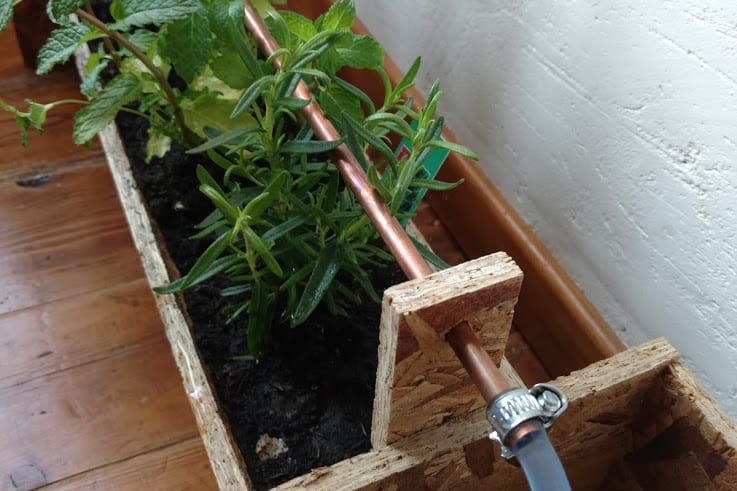After reading Steve Lohr’s book ‘Data-Ism‘, it became clear how big data – the recent evolution in computing, cheap computing power, cheap storage, cheap hardware – can make the jump to the tangible world. In his book, Lohr gives the example of a Californian winery that uses shitloads of sensors to track everything that happens in its vineyards. It enables ‘precision agriculture’ and the possibility of AB-testing two methods of managing crops. I wanted to do that on a microscale. I’ve been using a lot of datasets on this blog, but I decided it was time to create my own datasets: let’s AB-test growing spices!
A couple of weeks later…
After some initial sketches and hardware research it became clear I’d need a bigger budget, more time and perhaps a larger surface. So I decided to simply grow spices, with irrigation powered by a Raspberry Pi.
The hardware
The plant box is made out of:
- Some water-resistant OSB wood
- An 8mm copper pipe
- 10 mm tubes
- Silicone for the seams in the wood
- A water reservoir (a bottle can do)
- A knob
I had the wood cut in the correct size and I screwed everything together. There’s not a lot to it and I encourage you to be creative and design something more stylish than my creation.
The electronics used for this project:
- I got the Raspberry Pi 3B with power adapter as a Christmas gift. But any type will do. Not a Zero.
- Some jumper wires
- A 5v – 12v relay
- A water pump
- A power adapter with this
- A current distributor, perhaps with a fancy cable
What you also need: a web server that hosts PHP and MySQL. Currently, all calls by all devices are saved to the database, so you’re going to need some storage capacity. In the near future I will create a feature to turn this off.
I know nothing about electronics, so without my colleague Geert, I’d have lost a lot of time, accomplishing nothing or frying my Raspberry Pi. He gave me the relay and provided me with this electronics schematic. Check out his website.
The software
If I wanted to control the water pump using my mobile phone or my computer there were several ways to go forward. I considered and tried using IBM’s IoT ecosystem and NodeRed, but I wanted more flexibility and I wanted to do some actual coding, not just dragging and dropping nodes. I also considered running a web server on my Raspberry Pi, but I did not really want to go through that process. So I decided to do the following.
The Raspberry Pi sends a signal every ten seconds to my web server asking if it should water the plants. The web server does a lookup in the database if water has been requested by the user. It returns a JSON string with the appropriate information for the Rpi to water the plants. On that same moment, sensory data can be written away into the database. I have provided parameters for temperature and moisture, but I am not using it myself yet – it’s on the feature list. Water is requested through a very simple user interface that adds 5 seconds of water for every tap on the one and only button in the interface.
Technologies used are:
- HTML and CSS for a responsive user interface
- JavaScript/JQuery for communication between client and server
- PHP and MySQL for handling the requests of buth the user and the Raspberry Pi
- Python for programming the Raspberry Pi
You can find the GitHub repository here. What you should do to get it up and running:
- Upload everything in the ‘web’ folder to your web server
- Run the sql query from createtable.sql
- Modify sqllogin.php to match your MySQL credentials
- Modify setting.php and add a “secret word”
- Add egarden.py to your Rpi and make it boot automatically.
- Modify egarden.py and use the same “secret word”, also change the url to your file server
- Reboot the Raspberry Pi
Browse to the directory in your file server and add the url parameters “?token=the_secret_word_you_chose”. You are now ready to have your plants watered from anywhere in the world.
Enjoy lazy gardening!
Here’s a list of features you can expect to be added in the near future:
- Token saved to a cookie, so you don’t need to provide it every time (done! 23/05/2017)
- An admin panel
- to change the token
- to add multiple Raspberry Pi’s
- to turn storage of data off
- Sensory data: moisture & temperature
- Push notifications




